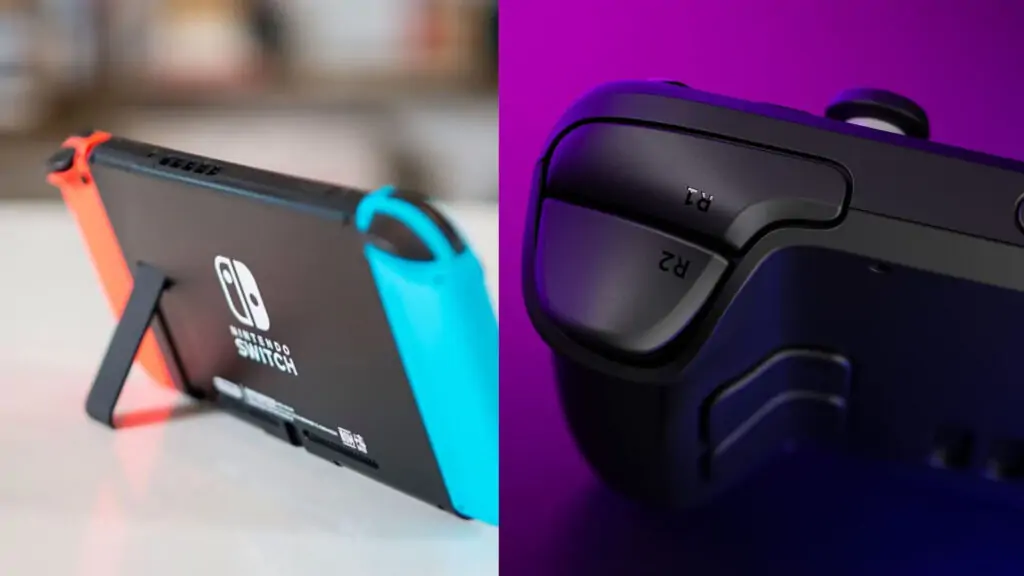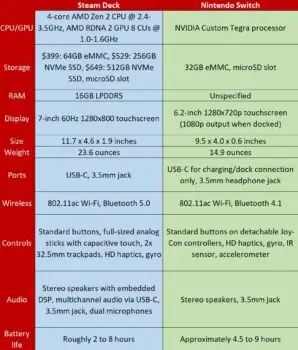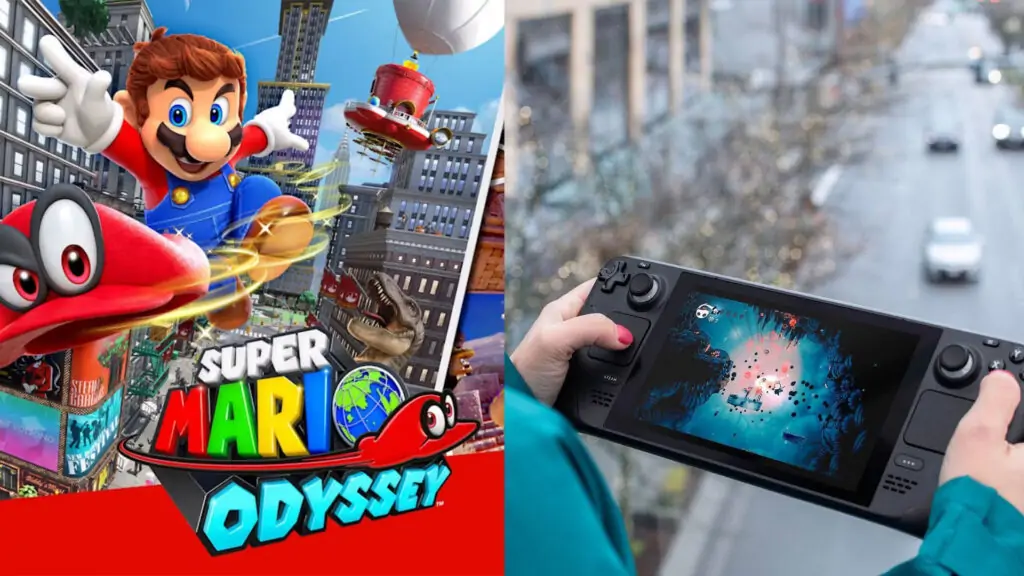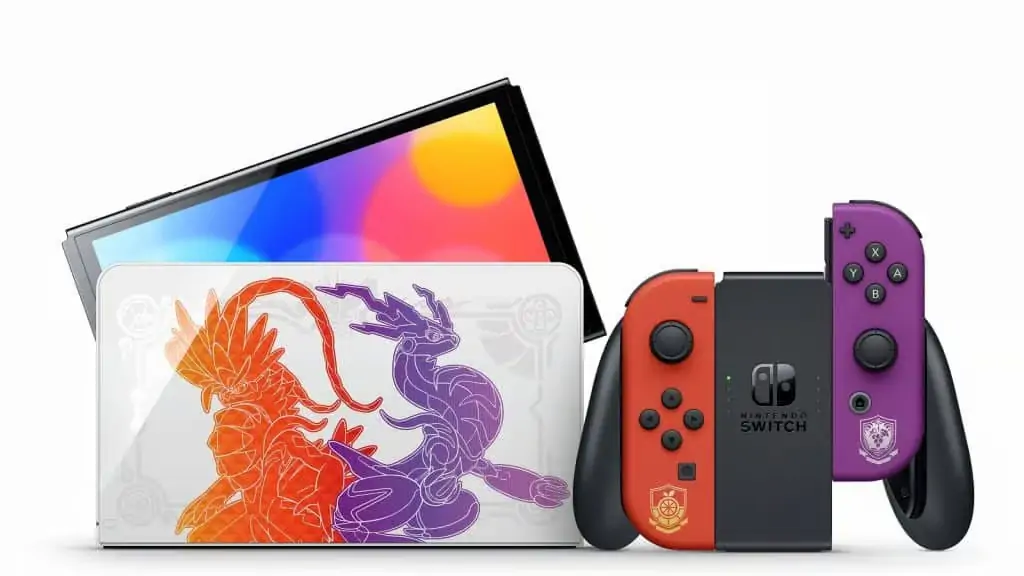![Steam Deck vs. Nintendo Switch: A Head-to-Head Comparison [2023] Nexus-Games](https://nexus-games.net/wp-content/uploads/2023/08/Nintendo-Switch-Vs-Steam-Deck.jpg.webp)
Two gaming giants have come to capture the hearts and minds of players everywhere in the ever-evolving portable gaming industry: Valve’s Steam Deck and Nintendo’s cherished Switch Steam Deck vs. Nintendo Switch: A Head-to-Head Comparison [2023]. These portable gaming systems all have distinctive advantages and capabilities of their own. To assist you in making a wise choice, we examine both gadgets in-depth in our thorough comparison. This tutorial will help you find your way through the confusing world of portable gaming devices, regardless of whether you’re an experienced player or just a casual gamer. So without further ado, let’s start this epic battle between the Nintendo Switch and Steam Deck.
Design and Build Quality: Form Meets Function
Steam Deck
The Steam Deck from Valve stands out from the competitors because to its industrial, futuristic appearance. Its ergonomic design, which makes use of strategically positioned thumbsticks and buttons, guarantees a pleasant grip throughout lengthy gaming sessions. The device’s 7-inch touchscreen provides enough space for intense gaming, and the controls are simple and quick to use.
The Steam Deck is made of high-quality materials and feels strong and long-lasting. The gaming experience is further improved by the buttons’ and analog sticks’ haptic feedback. Additionally, the availability of customisable trackpads creates additional opportunities for creative gaming, making it a flexible option for players of all skill levels.
Nintendo Switch
On the other hand, the Nintendo Switch has a more simplistic design that is distinguished by its distinctive modular architecture. One of its selling points is its hybrid nature, which enables games on both docked and portable devices. The Switch’s build quality is unquestionably strong, despite the fact that it may not have the Steam Deck’s futuristic appearance.
The Joy-Con controllers, which can be taken apart and used individually, provide the Switch more adaptability. However, some users have reported Joy-Con drift difficulties, which may be problematic. However, Nintendo’s dedication to offering a variety of vibrant, themed versions appeals to a wide audience.
Performance: Steam Deck with Power Under the Hood
Steam Deck
The Steam Deck has a unique AMD APU that combines a quad-core Zen 2 CPU with RDNA 2 architecture for the GPU hidden behind its svelte shell. This powerful hardware setup guarantees strong gaming performance, able to handle even demanding PC games. The 16GB of LPDDR5 RAM in the gadget guarantees fluid multitasking and rapid load times.
Although the Steam Deck is powered by SteamOS, Valve’s customized Linux-based operating system, users may also install other operating systems, giving it an unmatched degree of adaptability. With access to the vast Steam library, which includes AAA games and independent treasures, this freedom extends to game libraries. Steam Deck vs. Nintendo Switch: A Head-to-Head Comparison [2023].
Despite not being as technologically sophisticated as the Steam Deck, the Nintendo Switch competes well. It has a customized NVIDIA Tegra X1 processor that powers it, and it performs well given its size. Although 4GB of RAM may not seem like much in comparison, Nintendo has designed its games to work well with the system.
The strength of the Switch is found in its first-party games, which include classics like “The Legend of Zelda: Breath of the Wild” and “Super Mario Odyssey.” The Steam Deck tries to fix the issue that it sometimes have trouble running third-party games with demanding graphics.
How to Play Multiplayer Steam Games FREE
Gaming Library: A World of Choices
The compatibility of the Steam Deck with the enormous Steam library, which contains thousands of titles in a variety of genres, is one of its notable advantages. There are films for every taste, from independent treasures to box office smashes. Because to Valve’s dedication to backward compatibility, you may play new releases or relive old favorites.
Additionally, the open design of the Steam Deck enables you to install other game shops and even different operating systems, increasing your gaming possibilities. For those looking for a varied gaming experience, this versatility is revolutionary.
Nintendo’s Switch excels with its exclusive first-party games, while having a smaller selection of third-party games. For Nintendo enthusiasts, titles like “Animal Crossing: New Horizons,” “Splatoon 2,” and “Pokémon Sword and Shield” are alluring. A wide selection of independent games and vintage Nintendo console games are now available on the eShop.
Your membership gets more value thanks to the Nintendo Switch Online service, which gives you access to a growing collection of NES and SNES classics. It’s crucial to remember that the Steam Deck can be a better option if your main interest is in AAA games from other publishers.
The Nintendo Switch has built up an impressive library of games over the past few years, with the likes of Breath of the Wild, Super Mario Odyssey, Super Smash Bros. Ultimate and Animal Crossing: New Horizons all receiving universal praise.
Display & Graphics: Immersion in the Visual
Steam Deck
The 7-inch touchscreen display on the Steam Deck provides a clear and lively visual experience. It achieves a compromise between mobility and visual quality at a resolution of 1280×800 pixels. With the usage of an LCD display, vibrant colors and superb viewing angles are guaranteed, giving games a lifelike appearance.
Ray tracing capabilities are added to the Steam Deck by the GPU’s RDNA 2 architecture, providing a new degree of realism in compatible games. For gamers who need amazing visuals on the move, this is a big benefit.
Nintendo Switch
When in portable form, the Nintendo Switch has a 6.2-inch, 720p touchscreen display. Despite having a somewhat lesser resolution than the Steam Deck, the screen’s brightness and color provide for a fun gaming environment.
In contrast, the Switch’s graphics capabilities are constrained and thus is unable to handle ray tracing. If having cutting-edge visuals is important to you, the Steam Deck is the best option.
25 Best PC Games to Play Right Now [2023]
Is the Switch OLED better than the Steam Deck?
But it’s worth noting that the Switch’s OLED version has a larger and sharper screen. Outside of the Ayaneo, nothing on a handheld will match that screen. The Steam Deck’s screen, in contrast, is somewhat lifeless despite having superior panel quality and deep blacks.
The Steam Deck does, however, include future HDR support. The Switch OLED does not, as far as we know, support HDR. Even while it will provide a considerably brighter and more vibrant picture, without HDR to support it, it is merely a gimmick.
However, it seems that with the Steam Deck’s screen, only docking it to HDMI or DisplayPort monitors will make this capability available.
Conclusion: The Greatest Handheld Battle
Both the Steam Deck and Nintendo Switch bring unique strengths and weaknesses to the contest of portable gaming. The Steam Deck is a great option for gamers looking for a PC-like experience on the road thanks to its robust hardware, large game catalog, and versatility.
On the other hand, Nintendo fans and casual gamers alike like the Nintendo Switch for its distinctive hybrid design, exclusive first-party games, and obvious charm.
The decision between the Steam Deck and Nintendo Switch ultimately comes down to your priorities and preferred games. Do you like cutting-edge visuals and a huge game selection, or are Nintendo’s venerable brands and portability more appealing to you? You have a choice, and both options guarantee hours of game enjoyment.
YOU MAY ALSO LIKE:
- 5 Common PC Gaming Problems (And How to Fix Them)
- How To Download Torrent Games (2023)
- How to Get Steam Games For FREE 2023
- 0 Comment
- All Games, How To, NexusGames Guides, Tutorials
- August 27, 2023







![Steam Deck vs. Nintendo Switch: A Head-to-Head Comparison [2023]](https://nexus-games.net/wp-content/uploads/2023/08/Nintendo-Switch-Vs-Steam-Deck-90x65.jpg.webp)


![25 Best PC Games to Play Right Now [2024]](https://nexus-games.net/wp-content/uploads/2023/03/25-Best-PC-Games-to-Play-Right-Now-Nexus-Games-90x65.jpg.webp)
